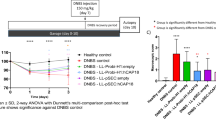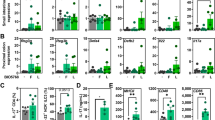Abstract
Genetically modified Lactococcus lactis secreting interleukin 10 provides a therapeutic approach for inflammatory bowel disease. However, the release of such genetically modified organisms through clinical use raises safety concerns. In an effort to address this problem, we replaced the thymidylate synthase gene thyA of L. lactis with a synthetic human IL10 gene. This thyA−hIL10+ L. lactis strain produced human IL-10 (hIL-10), and when deprived of thymidine or thymine, its viability dropped by several orders of magnitude, essentially preventing its accumulation in the environment. The biological containment system and the bacterium's capacity to secrete hIL-10 were validated in vivo in pigs. Our approach is a promising one for transgene containment because, in the unlikely event that the engineered L. lactis strain acquired an intact thyA gene from a donor such as L. lactis subsp. cremoris, the transgene would be eliminated from the genome.
This is a preview of subscription content, access via your institution
Access options
Subscribe to this journal
Receive 12 print issues and online access
$209.00 per year
only $17.42 per issue
Buy this article
- Purchase on Springer Link
- Instant access to full article PDF
Prices may be subject to local taxes which are calculated during checkout



Similar content being viewed by others
Accession codes
References
Steidler, L. et al. Mucosal delivery of murine interleukin-2 (IL-2) and IL-6 by recombinant strains of Lactococcus lactis coexpressing antigen and cytokine. Infect. Immun. 66, 3183–3189 (1998).
Steidler, L. et al. Treatment of murine colitis by Lactococcus lactis secreting interleukin-10. Science 289, 1352–1355 (2000).
Beninati, C. et al. Therapy of mucosal candidiasis by expression of an anti-idiotype in human commensal bacteria. Nat. Biotechnol. 18, 1060–1064 (2000).
Kruger, C. et al. In situ delivery of passive immunity by lactobacilli producing single- chain antibodies. Nat. Biotechnol. 20, 702–706 (2002).
van Deventer, S.J., Elson, C.O. & Fedorak, R.N. Multiple doses of intravenous interleukin 10 in steroid-refractory Crohn's disease. Crohn's Disease Study Group. Gastroenterology 113, 383–389 (1997).
Fedorak, R.N. et al. Recombinant human interleukin 10 in the treatment of patients with mild to moderately active Crohn's disease. The Interleukin 10 Inflammatory Bowel Disease Cooperative Study Group. Gastroenterology 119, 1473–1482 (2000).
Schreiber, S. et al. Safety and efficacy of recombinant human interleukin 10 in chronic active Crohn's disease. Crohn's Disease IL-10 Cooperative Study Group. Gastroenterology 119, 1461–1472 (2000).
Tilg, H., Ulmer, H., Kaser, A. & Weiss, G. Role of IL-10 for induction of anemia during inflammation. J. Immunol. 169, 2204–2209 (2002).
Schotte, L., Steidler, L., Vandekerckhove, J. & Remaut, E. Secretion of biologically active murine interleukin-10 by Lactococcus lactis. Enzyme Microb. Technol. 27, 761–765 (2000).
Masood, R. et al. Interleukin-10 is an autocrine growth factor for acquired immuno-deficiency syndrome-related B-cell lymphoma. Blood 85, 3423–3430 (1995).
Ross, P., O'Gara, F. & Condon, S. Cloning and characterization of the thymidylate synthase gene from Lactococcus lactis subsp. lactis. Appl. Environ. Microbiol. 56, 2156–2163 (1990).
Biswas, I., Gruss, A., Ehrlich, S.D. & Maguin, E. High-efficiency gene inactivation and replacement system for gram-positive bacteria. J. Bacteriol. 175, 3628–3635 (1993).
Bolotin, A. et al. The complete genome sequence of the lactic acid bacterium Lactococcus lactis ssp. lactis IL1403. Genome Res. 11, 731–753 (2001).
Law, J. et al. A system to generate chromosomal mutations in Lactococcus lactis which allows fast analysis of targeted genes. J. Bacteriol. 177, 7011–7018 (1995).
Waterfield, N.R., Le Page, R.W., Wilson, P.W. & Wells, J.M. The isolation of lactococcal promoters and their use in investigating bacterial luciferase synthesis in Lactococcus lactis. Gene 165, 9–15 (1995).
Stemmer, W.P., Crameri, A., Ha, K.D., Brennan, T.M. & Heyneker, H.L. Single-step assembly of a gene and entire plasmid from large numbers of oligodeoxyribonucleotides. Gene 164, 49–53 (1995).
van Asseldonk, M. et al. Cloning of usp45, a gene encoding a secreted protein from Lactococcus lactis subsp. lactis MG1363. Gene 95, 155–160 (1990).
Barthelemy, I. et al. Production and secretion of human interleukin 6 into the periplasm of Escherichia coli: efficient processing of N-terminal variants of hIL6 by the E. coli signal peptidase. J. Biotechnol. 27, 307–316 (1993).
Thompson-Snipes, L. et al. Interleukin 10: a novel stimulatory factor for mast cells and their progenitors. J. Exp. Med. 173, 507–510 (1991).
Giard, J.C., Verneuil, N., Auffray, Y. & Hartke, A. Characterization of genes homologous to the general stress-inducible gene gls24 in Enterococcus faecalis and Lactococcus lactis. FEMS Microbiol. Lett. 206, 235–239 (2002).
Decuypere, J.A., Vervaeke, I.J., Henderickx, H.K. & Dierick, N.A. Gastro-intestinal cannulation in pigs: a simple technique allowing multiple replacements. J. Anim. Sci. 45, 463–468 (1977).
Molin, S. et al. Suicidal genetic elements and their use in biological containment of bacteria. Annu. Rev. Microbiol. 47, 139–166 (1993).
Molina, L., Ramos, C., Ronchel, M.C., Molin, S. & Ramos, J.L. Construction of an efficient biologically contained Pseudomonas putida strain and its survival in outdoor assays. Appl. Environ. Microbiol. 64, 2072–2078 (1998).
Knudsen, S. et al. Development and testing of improved suicide functions for biological containment of bacteria. Appl. Environ. Microbiol. 61, 985–991 (1995).
Schweder, T., Hofmann, K. & Hecker, M. Escherichia coli K12 relA strains as safe hosts for expression of recombinant DNA. Appl. Microbiol. Biotechnol 42, 718–723 (1995).
Torres, B., Jaenecke, S., Timmis, K.N., Garcia, J.L. & Diaz, E. A gene containment strategy based on a restriction-modification system. Environ. Microbiol. 2, 555–563 (2000).
Diaz, E., Munthali, M., de Lorenzo, V. & Timmis, K.N. Universal barrier to lateral spread of specific genes among microorganisms. Mol. Microbiol. 13, 855–861 (1994).
Bron, P.A. et al. Use of the alr gene as a food-grade selection marker in lactic acid bacteria. Appl. Environ. Microbiol. 68, 5663–5670 (2002).
MacCormick, C.A., Griffin, H.G. & Gasson, M.J. Construction of a food-grade host/vector system for Lactococcus lactis based on the lactose operon. FEMS Microbiol. Lett. 127, 105–109 (1995).
Sorensen, K.I., Larsen, R., Kibenich, A., Junge, M.P. & Johansen, E. A food-grade cloning system for industrial strains of Lactococcus lactis. Appl. Environ. Microbiol. 66, 1253–1258 (2000).
Ahmad, S.I., Kirk, S.H. & Eisenstark, A. Thymine metabolism and thymineless death in prokaryotes and eukaryotes. Ann. Rev. Microbiol. 52, 591–625 (1998).
Cohen, S.S. & Barner, H.D. Studies on unbalanced growth in Escherichia coli. Proc. Natl. Acad. Sci. USA 40, 885–893 (1954).
Fu, X. & Xu, J.G. Development of a chromosome-plasmid balanced lethal system for Lactobacillus acidophilus with thyA gene as selective marker. Microbiol. Immunol. 44, 551–556 (2000).
Pedersen, M.B., Jensen, P.R., Janzen, T. & Nilsson, D. Bacteriophage resistance of a ΔthyA mutant of Lactococcus lactis blocked in DNA replication. Appl. Environ. Microbiol. 68, 3010–3023 (2002).
Bringel, F., Van Alstine, G.L. & Scott, J.R. A host factor absent from Lactococcus lactis subspecies lactis MG1363 is required for conjugative transposition. Mol. Microbiol. 5, 2983–2993 (1991).
Moon, H.W., Sorensen, D.K. & Sautter, J.H. Escherichia coli infection of the ligated intestinal loop of the newborn pig. Am. J. Vet. Res. 27, 11317–11325 (1966).
Acknowledgements
The authors thank Inge Bruggeman, Hilde Devlies Koen Van Laer and Elena Yancheva for expert technical assistance, Karen Madsen, Claude Cuvelier and Frans Van Roy for critically reviewing the manuscript, and Jan Kok and Emmanuelle Maguin for providing genetic tools. This study was financed by the Vlaams Interuniversitair instituut voor Biotechnologie, Ghent University (GOA project nos. 12050700 and 12051501) and the commission of the European Communities, specific research, technological development and training activities program “Quality of Life and Management of Living Resources,” QLK1-2000-00146 “Probiotic strains with designed health properties.”
Author information
Authors and Affiliations
Corresponding author
Ethics declarations
Competing interests
The authors declare no competing financial interests.
Rights and permissions
About this article
Cite this article
Steidler, L., Neirynck, S., Huyghebaert, N. et al. Biological containment of genetically modified Lactococcus lactis for intestinal delivery of human interleukin 10. Nat Biotechnol 21, 785–789 (2003). https://doi.org/10.1038/nbt840
Received:
Accepted:
Published:
Issue Date:
DOI: https://doi.org/10.1038/nbt840
This article is cited by
-
Engineering stringent genetic biocontainment of yeast with a protein stability switch
Nature Communications (2024)
-
Cas9-assisted biological containment of a genetically engineered human commensal bacterium and genetic elements
Nature Communications (2024)
-
Engineering the gut microbiome
Nature Reviews Bioengineering (2023)
-
A robust yeast biocontainment system with two-layered regulation switch dependent on unnatural amino acid
Nature Communications (2023)
-
Treatment with a Lactococcus lactis that chromosomally express E. coli cfaI mitigates salivary flow loss in a Sjögren’s syndrome-like disease
Scientific Reports (2023)



